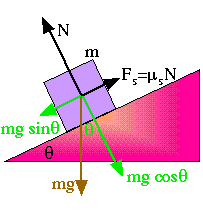

The force of friction is independent of the area of contact between the object and the surface. The coefficient of kinetic friction can depend on velocity, but usually we will ignore this effect when working problems.
 One can determine the coefficient of static friction between an
object and a sliding surface by tilting the surface with the object
on the surface as shown below. In this figure, we have split mg into
its components perpendicular and parallel to the surface.
One can determine the coefficient of static friction between an
object and a sliding surface by tilting the surface with the object
on the surface as shown below. In this figure, we have split mg into
its components perpendicular and parallel to the surface.
As long as the green forces are balanced by the black ones, the object will be at rest (or moving with constant velocity.)
We can now slowly increase the angle of the surface until the object starts to slide. At this point, we have found the maximum static friction force, Fs,max, which was just discussed. At this limiting angle, we then have (see drawing) for the force equation along the plane:
One can also see that the equation for force perpendicular to the plane gives:
Combine both equations to get:
=>
Therefore, by measuring the angle
In a similar way one can study kinetic friction on an inclined plane by measuring the angle at which the block slides at constant velocity. Now we get:
© MultiMedia Physics, 1999